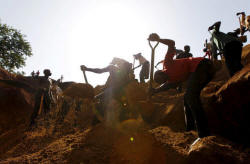Goldplat miner seeks to tame Africa risk
 Send a link to a friend
Send a link to a friend
 [September 19, 2017]
By Barbara Lewis [September 19, 2017]
By Barbara Lewis
LONDON (Reuters) - Upheaval in Tanzania,
where the government has made huge tax demands and seized minerals, has
triggered changes in neighboring Kenya, which should reassure the
industry, said the CEO of Goldplat, which operates a gold mine there.
Chief Executive Gerard Kisbey-Green said he was nevertheless seeking to
diversify his portfolio to cover more African nations and to expand into
platinum group metals as he strives to offset African risk.
This year, the mining industry has reeled from South Africa's proposed
new mining charter and changes in Tanzania, where the government is
locked in a tax dispute with Barrick Gold <ABX.TO> subsidiary Acacia <ACAA.L>.
Kisbey-Green said the impact of the Tanzanian actions in Kenya was "a
positive contagion effect" as the mining ministry has requested the
opportunity to inspect and has offered to assay each bar of bullion
exported.

"It means our gold exports take a day longer, but I would rather that
than have the government turn round and say we have been stealing their
gold," he said.
The Kenyan Mining Ministry was not immediately available for comment.
Set up around four years ago, the ministry's aim is to develop the
country's mineral deposits, which include titanium, gold and coal.
Concerns about political instability are also high in Kenya after
elections in August were nullified and a re-run is scheduled for
October.
Kisbey-Green said he thought the only disruption to Goldplat's Kenyan
mine would be two days lost production as workers went to vote.
Killmapesa in Kenya is Goldplat's only producing mine. The rest of its
output is from extracting gold from mine waste in South Africa and
Ghana.
[to top of second column] |

Gold prospectors work at an open-pit mine in the village of Kogelo,
west of Kenya's capital Nairobi, July 15, 2015. REUTERS/Thomas
Mukoya/File Photo

One option to reduce political risk is to register the company in South Africa
as, for instance, a factory rather than a resources company, given that it
processes mining waste rather than mines in South Africa. That would shelter it
from the mining charter.
Goldplat is also seeking to spread risk by diversifying geographically and to
expand across the platinum group of metals as the South African gold sector is
very mature.
"You should not have over-exposure to one country in Africa or in any emerging
markets," Kisbey-Green said.
The aim over around three years is to increase output across a spread of
jurisdictions by around 25 percent from recovery operations to roughly 50,000
ounces per year and to increase mining productivity from around 5,000 ounces
annually to 50,000 ounces through development and acquisitions.
Like many miners, Goldplat is recovering from the commodity crash of 2015-16 as
markets rally, and on Monday reported a 140 percent increase in operating
profit. Since the start of the year, its shares have risen 24 percent.
(Additional reporting by George Obulutsa in Nairobi, editing by Louise Heavens)
[© 2017 Thomson Reuters. All rights
reserved.] Copyright 2017 Reuters. All rights reserved. This material may not be published,
broadcast, rewritten or redistributed.
 |